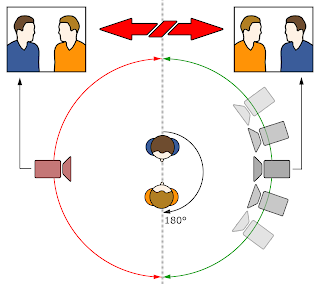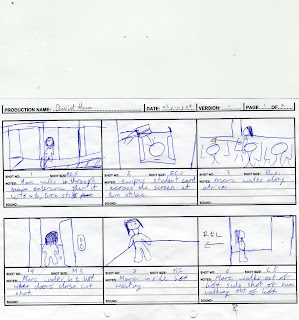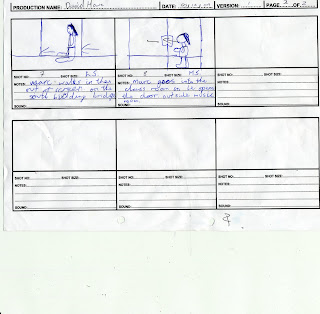8 Shot Journey
For productions of films there are 3 main parts to the production process.
The first is pre-production:- at this stage of production you have to get the things to help you shot your production, these are story boards, finding the location, gathering props and creating the script for your production.
The actual production: - this is when you use all your pre-production resources. This is when you get footage for editing so this is shooting your production, recording the sound and just generally gathering all recourses that you need to piece together your production in editing.
Post-production (project in post):- this is getting the project to the final stage and getting the finished version, this is editing the project and part of this is transferring the clips of footage on to computer, this can be a very long and tiring process, then the final thing to do in this process is evaluating the work.
Cinematography laws
&
Do’s and don’ts
The way that a film is made up is fairly complex, but the best way to describe how to build up a film is by describing it like an essay, this is the scale that it goes in: - frames are a letter, shots are a word, sequences are a sentence, scenes are a paragraph and movies/programs are an essay.
Here are the definitions of what different parts of a film reel are:-
Frame is a single cell of a film reel.
A shot is a continues strip of motion picture film, created by a series of frames, that runs for an uninterrupted period of time.
A scene is part of the action that happens in one location and changes when the location changes.
A sequence is a series of scenes that flow together into each other.
A movie or program is the whole body or all the scenes put together.
Shot sizes
Shot sizes can range from extreme close up to a very long shot .different shot’s are good for establishing shots to get the correct shot that you want and want to create. to determine what size of shot you need, you have to decide what the viewer would want to see. for the viewer to have your ideas established to them you should show a lot and leave the shot for a while to give the viewer more information about the scene, a close up is used to show things about a person or character.
Composition: Rule of 1/3rds
For this rule a lot of objects are placed to the side of the scene rather than a centred shot to give the character or moving image room or space to move into. To make more sense of this people often draw a norts and crosses grid in their head, the top line across should be in the eye line of the person or character; this makes the shot look better and more creative. The bottom line of this is usually the horizon line, so this is where the sky and the land meet often but not all the time. The vertical lines are often where action is placed around or in the middle of. Here is an example of the grid
For productions of films there are 3 main parts to the production process.
The first is pre-production:- at this stage of production you have to get the things to help you shot your production, these are story boards, finding the location, gathering props and creating the script for your production.
The actual production: - this is when you use all your pre-production resources. This is when you get footage for editing so this is shooting your production, recording the sound and just generally gathering all recourses that you need to piece together your production in editing.
Post-production (project in post):- this is getting the project to the final stage and getting the finished version, this is editing the project and part of this is transferring the clips of footage on to computer, this can be a very long and tiring process, then the final thing to do in this process is evaluating the work.
Cinematography laws
&
Do’s and don’ts
The way that a film is made up is fairly complex, but the best way to describe how to build up a film is by describing it like an essay, this is the scale that it goes in: - frames are a letter, shots are a word, sequences are a sentence, scenes are a paragraph and movies/programs are an essay.
Here are the definitions of what different parts of a film reel are:-
Frame is a single cell of a film reel.
A shot is a continues strip of motion picture film, created by a series of frames, that runs for an uninterrupted period of time.
A scene is part of the action that happens in one location and changes when the location changes.
A sequence is a series of scenes that flow together into each other.
A movie or program is the whole body or all the scenes put together.
Shot sizes
Shot sizes can range from extreme close up to a very long shot .different shot’s are good for establishing shots to get the correct shot that you want and want to create. to determine what size of shot you need, you have to decide what the viewer would want to see. for the viewer to have your ideas established to them you should show a lot and leave the shot for a while to give the viewer more information about the scene, a close up is used to show things about a person or character.
Composition: Rule of 1/3rds
For this rule a lot of objects are placed to the side of the scene rather than a centred shot to give the character or moving image room or space to move into. To make more sense of this people often draw a norts and crosses grid in their head, the top line across should be in the eye line of the person or character; this makes the shot look better and more creative. The bottom line of this is usually the horizon line, so this is where the sky and the land meet often but not all the time. The vertical lines are often where action is placed around or in the middle of. Here is an example of the grid
180 Degree Line Rule
This is an imaginary line that you often put through your shot. You can only one side of the line not both sides of the line. This is because it can stop the character going in one direction and confuse the viewers and make the sequence look wrong and not flowing. However you can break this rule by moving the camera over the line but you have to show the viewer that you are moving across the line so it will make sense, here is a diagram to show this
This is an imaginary line that you often put through your shot. You can only one side of the line not both sides of the line. This is because it can stop the character going in one direction and confuse the viewers and make the sequence look wrong and not flowing. However you can break this rule by moving the camera over the line but you have to show the viewer that you are moving across the line so it will make sense, here is a diagram to show this

Camera Angle
There are different camera angles that can create and mean different things. This can cause the viewer to focus more or find it more interesting as it changes their view as it is different to what we see in real life as we often see things at eye height angles not low angles or high angles. Here are some of the different angles and what they usually mean…
High angle- a shot made pointing down on a character to make the character seem inferior.
Low angle- can make the character seem superior.
Ground level- makes the shot more interesting and can often make a scene seem to speed up as it can be a shot of someone running.
Diagonal line- can give a view of something that we don’t focus on straight away.
There are different camera angles that can create and mean different things. This can cause the viewer to focus more or find it more interesting as it changes their view as it is different to what we see in real life as we often see things at eye height angles not low angles or high angles. Here are some of the different angles and what they usually mean…
High angle- a shot made pointing down on a character to make the character seem inferior.
Low angle- can make the character seem superior.
Ground level- makes the shot more interesting and can often make a scene seem to speed up as it can be a shot of someone running.
Diagonal line- can give a view of something that we don’t focus on straight away.
Focus
Focus is about depth of field or shot, if you make things in focus that you want people to see then you focus on that particular thing focused and everything around it blurred or a tiny bit blurred. A deep focus is often when everything in shot is focused.
Continuity
Continuity of travel is when you keep the character moving out of the screen then coming on so it looks like they are walking through each shot so if they leave a shot from the right of the screen they then enter the next shot from the left of the screen.
Hierarchy of film production
Focus is about depth of field or shot, if you make things in focus that you want people to see then you focus on that particular thing focused and everything around it blurred or a tiny bit blurred. A deep focus is often when everything in shot is focused.
Continuity
Continuity of travel is when you keep the character moving out of the screen then coming on so it looks like they are walking through each shot so if they leave a shot from the right of the screen they then enter the next shot from the left of the screen.
Hierarchy of film production
8 Shot Journey
For our project we had to create a short film about some on going on a journey to some where and them getting their we had to have a range of still shots at different angles with different shot sizes, we also had to plan what we would do for filming, we did this by using story boards and as we filmed we had to do log sheets here they are…
For our project we had to create a short film about some on going on a journey to some where and them getting their we had to have a range of still shots at different angles with different shot sizes, we also had to plan what we would do for filming, we did this by using story boards and as we filmed we had to do log sheets here they are…



my 8 Shot Journey.. (watch in mute)




No comments:
Post a Comment